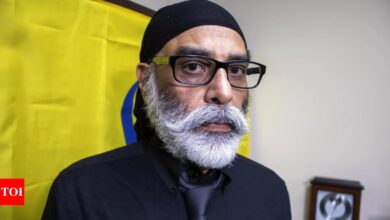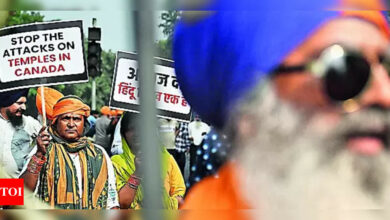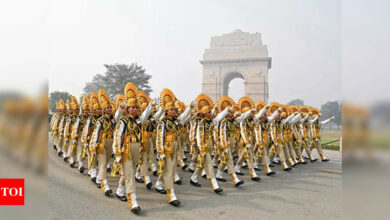India
Muharram’s ‘alams’: Sign of eternal victory, sorrow | India News – Times of India
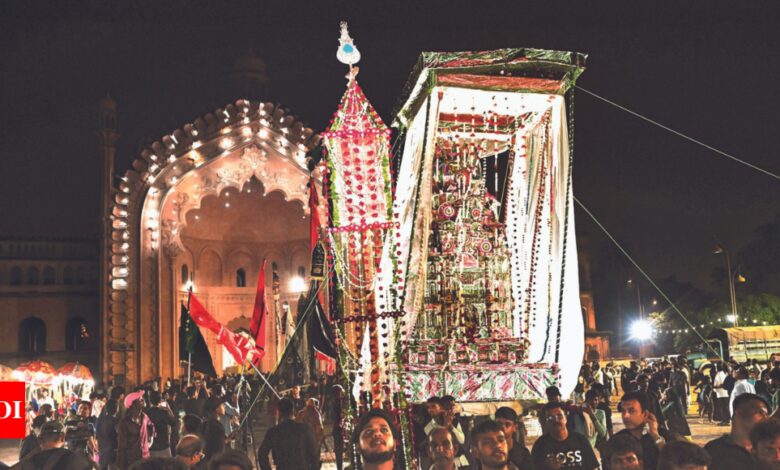
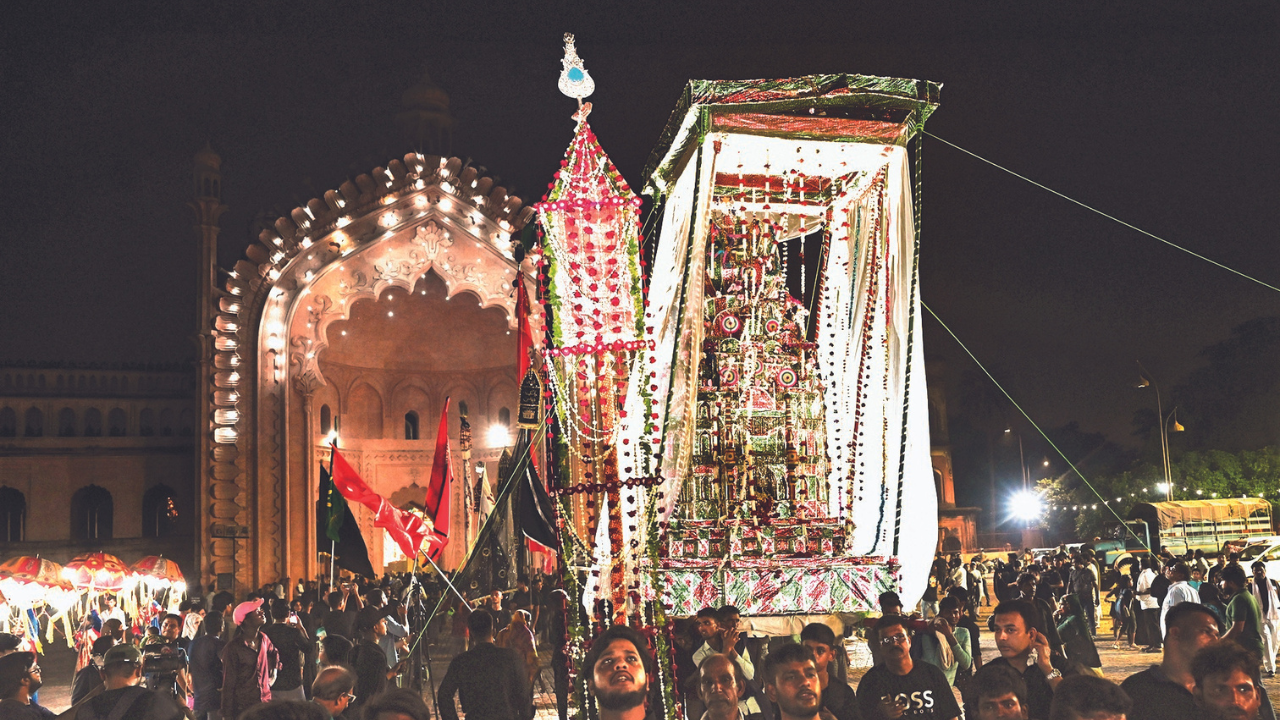

‘Alams’, an integral part of Muharrum observations, are installed in ‘Shahnasheen’ where ‘zaris’ and ‘tazias’ are kept in public and household imambaras. They are also taken out in processions.
‘Tazia’ and ‘zaris’ are replicas of the shrine of Imam Hussain in Karbala, Iraq.
‘Alam‘ is the sign of the eternal victory of Imam Hussein, but also of sorrow, because his head, along with those of other martyrs, was hoisted on spears and paraded from city to city.
The tragedy of Karbala took place in 680 AD, when 30 years after the death of Prophet Muhammad, a tyrannical Ummahiyad king, Yazid, proclaimed himself the Caliph of Islam. He demanded allegiance from Imam Hussain, the grandson of Prophet Muhammad, by asking Hussain’s hand under his own, as the practice of submission was widespread at that time.
However, rather than give in to Yazid’s tyrannical, unjust and immoral rule, Imam Hussain gave up his own head and that of his 72 followers in the battle that followed on the 10th day of the month of Muharrum in Karbala, Iraq, in 61 Hijri (10 October 680 CE).
To indicate that Hussain’s hand was higher than Yazid’s, the metal emblem of the human hand on a decorated wooden club is called ‘alam’.
The sign of the five of a human hand also symbolizes belief in the holy five: Muhammad, Ali, Fatema, Hasan and Hussain.
In modern military jargon, ‘alam’ means flag, standard or the colour assigned to a fighting unit. In Islamic tradition, the bearer of this flag is called ‘alambardar’. There have been three legendary flag bearers in Islamic history – Maula Ali, father of Imam Hussain, Ali’s brother Hazrat Jafar, and another son of Maula Ali, Hazrat Abbas.
Like Ali, Jafar and Abbas were synonymous with bravery and victory. However, in ‘Jang-e-Maota’ (Battle of Maota), both of Jafar’s arms were cut off. According to Islamic tradition, Allah gave him two wings of ‘zamrud’ (emerald) in heaven, which is why Jafar’s ‘alam’ is completely green, decorated with two wing-shaped insignia on the top.
The ‘alam’ of Abbas, who also lost both his weapons in the battle of Karbala, is now the main ‘alam’. As he tried to give his ‘mashk’ (water bag) to the thirsty children of Hussain, a small ‘mashk’ made of cloth is attached to this ‘alam’. It is a reminder of his tireless but failed efforts to give water to the children of Hussain who were thirsty for three days, as the water supply for Hussain and his followers was blocked by Yazid’s army.
The enemy’s arrow pierced the ‘mashk’ of Abbas and the water meant for the thirsty children of Hussain was spilled on the sands of Karbala. Since then the ‘mashk’ has been a part of the ‘Alam’ of Abbas.
This ‘mashk’ is called ‘Mashk-e-Sakina’, the water bag of Imam Hussain’s four-year-old daughter Sakina. She gave the bag to his uncle Abbas to fetch water for the thirsty children.
The ‘alam’ of Abbas consists of five basic parts: ‘chad’ (wooden club), ‘faraira’ (triangular flag-like cloth attached to this club), ‘patka’ (the rectangular banner decorated with gold and silver embroidery), ‘mashk’ (symbolic water bag) and ‘panja’ (the emblem of the holy hand).
Originally ‘alam’ only had a light green ‘faraira’, but now it is black or white with red spots symbolizing the blood of Abbas.
‘Patka’ is a later addition to ‘alam’. Perhaps the practice of Muslim courts and royal processions carrying rectangular banners decorated with the Qur’anic verses was extended to Muharrum ‘alam’.
In the movie ‘Razia Sultan‘, filmmaker Kamal Amrohi depicted similar banners being held by the Sultanate’s army. Similarly, ‘alam’-like banners are attached to cloth-wrapped clubs in a hall of Jodhpur’s Mehrangarh Fort. Banners resembling ‘patka’ are also carried in religious processions from Christian monasteries in Iraq, Syria, Central Asia and Europe.
Muslim states in India, especially the Shia rulers of Awadh, Murshidabad, Bengal, Hyderabad, Rampurand Mahmudabad gave a royal touch to ‘azadari’ (Muharrum celebrations).
Also, alams of precious metals and ‘patkas’ were decorated as royal banners.
In India, the interface between Indian and Islamic traditions is mutually enriching. The tower atop the Badal Palace in Jaisalmer is called ‘Tazia Tower’ because it resembles the ‘tazia’ that was removed during Muharrum.
During Muharrum, such ‘alams’ are exhibited annually in public and private imambaras across the subcontinent.
Over time, the symbols of the holy hand of ‘alam’ changed in design, motif and size.
Among the other unusual patterns, the ‘Taimuri alam’ of Mahmudabad Fort Imambara is a rare antique article.
Similarly, complete ‘alams’, now a rarity, are installed in the imambara of Nawab Luft Ali Khan and Badshah Nawab Sahab in Patna, Bihar. Only four ‘alams’ of this kind are seen in Lucknow.
They are installed in Qasr-e-Hussaini, Naya Najaf, Imambara of Agha Baqar and Imambara of Ghariyali in Chowk.
In Iraq and Iran, huge ‘alams’ are transported on trolleys.
Imambara family of historian Rana Safvi In the town of Jalali in Aligarh and in Shamshabad and Farrukhabad, beautiful embroidered ‘patkas’ have been preserved, which have been preserved for generations.
Beautiful traditional ‘patkas’ and ‘Awazi alam’ (gems dangling from either side of the emblem) can be seen in the imambara of Deputy Sheriff Azeem Sahab at the Sultan Palace in Wazirganj, Lucknow.
Awadh historian Ammar-e-Yasir has an enchanting collection of various ancient ‘alams’. His explanation of the articles is equally fascinating.
‘Par-e-buraq’, ‘jangi alam’, ‘doo saifi’, ‘naiza’, ‘nishan’, ‘tughra alam’ (grilled calligraphy), ‘alam-e-mahi (fish), ‘taoos’ (peacock), ‘sher daha’ (lion head), ‘zareechy’ (wooden ‘patka’), ‘safai-e-birangi’ (fine rice like border), ‘do saifi’, ‘teenage saifi‘ (double and triple swords), ‘panja’, ‘zuliqari’ and ‘awezi alam’ are names given based on their design.
‘Zulfqari alam’ is seen on the lid (the stepped pulpit) of Kala Imambara of Lucknow.
Insignia of the holy hand of ‘alam’ also have a symbolic participatory appeal. In Muharrum ‘majlis’ people raise both their hands in the shout of the slogan ‘Labbaik Ya Husain’ (Yes Hussain, we are here to be with you).
In India, during the 10 main days of Muharrum, there are three important processions. ‘Bibi ka alam’ of Hyderabad, Telangana, and ‘Alam Fatahe Furat’ and Alam Shabe Ashur in Lucknow. Muharrum congregations in Srinagar, Zadibal, Badgam and Kargil of Jammu & Kashmir are also important.
‘Tazia’ and ‘zaris’ are replicas of the shrine of Imam Hussain in Karbala, Iraq.
‘Alam‘ is the sign of the eternal victory of Imam Hussein, but also of sorrow, because his head, along with those of other martyrs, was hoisted on spears and paraded from city to city.
The tragedy of Karbala took place in 680 AD, when 30 years after the death of Prophet Muhammad, a tyrannical Ummahiyad king, Yazid, proclaimed himself the Caliph of Islam. He demanded allegiance from Imam Hussain, the grandson of Prophet Muhammad, by asking Hussain’s hand under his own, as the practice of submission was widespread at that time.
However, rather than give in to Yazid’s tyrannical, unjust and immoral rule, Imam Hussain gave up his own head and that of his 72 followers in the battle that followed on the 10th day of the month of Muharrum in Karbala, Iraq, in 61 Hijri (10 October 680 CE).
To indicate that Hussain’s hand was higher than Yazid’s, the metal emblem of the human hand on a decorated wooden club is called ‘alam’.
The sign of the five of a human hand also symbolizes belief in the holy five: Muhammad, Ali, Fatema, Hasan and Hussain.
In modern military jargon, ‘alam’ means flag, standard or the colour assigned to a fighting unit. In Islamic tradition, the bearer of this flag is called ‘alambardar’. There have been three legendary flag bearers in Islamic history – Maula Ali, father of Imam Hussain, Ali’s brother Hazrat Jafar, and another son of Maula Ali, Hazrat Abbas.
Like Ali, Jafar and Abbas were synonymous with bravery and victory. However, in ‘Jang-e-Maota’ (Battle of Maota), both of Jafar’s arms were cut off. According to Islamic tradition, Allah gave him two wings of ‘zamrud’ (emerald) in heaven, which is why Jafar’s ‘alam’ is completely green, decorated with two wing-shaped insignia on the top.
The ‘alam’ of Abbas, who also lost both his weapons in the battle of Karbala, is now the main ‘alam’. As he tried to give his ‘mashk’ (water bag) to the thirsty children of Hussain, a small ‘mashk’ made of cloth is attached to this ‘alam’. It is a reminder of his tireless but failed efforts to give water to the children of Hussain who were thirsty for three days, as the water supply for Hussain and his followers was blocked by Yazid’s army.
The enemy’s arrow pierced the ‘mashk’ of Abbas and the water meant for the thirsty children of Hussain was spilled on the sands of Karbala. Since then the ‘mashk’ has been a part of the ‘Alam’ of Abbas.
This ‘mashk’ is called ‘Mashk-e-Sakina’, the water bag of Imam Hussain’s four-year-old daughter Sakina. She gave the bag to his uncle Abbas to fetch water for the thirsty children.
The ‘alam’ of Abbas consists of five basic parts: ‘chad’ (wooden club), ‘faraira’ (triangular flag-like cloth attached to this club), ‘patka’ (the rectangular banner decorated with gold and silver embroidery), ‘mashk’ (symbolic water bag) and ‘panja’ (the emblem of the holy hand).
Originally ‘alam’ only had a light green ‘faraira’, but now it is black or white with red spots symbolizing the blood of Abbas.
‘Patka’ is a later addition to ‘alam’. Perhaps the practice of Muslim courts and royal processions carrying rectangular banners decorated with the Qur’anic verses was extended to Muharrum ‘alam’.
In the movie ‘Razia Sultan‘, filmmaker Kamal Amrohi depicted similar banners being held by the Sultanate’s army. Similarly, ‘alam’-like banners are attached to cloth-wrapped clubs in a hall of Jodhpur’s Mehrangarh Fort. Banners resembling ‘patka’ are also carried in religious processions from Christian monasteries in Iraq, Syria, Central Asia and Europe.
Muslim states in India, especially the Shia rulers of Awadh, Murshidabad, Bengal, Hyderabad, Rampurand Mahmudabad gave a royal touch to ‘azadari’ (Muharrum celebrations).
Also, alams of precious metals and ‘patkas’ were decorated as royal banners.
In India, the interface between Indian and Islamic traditions is mutually enriching. The tower atop the Badal Palace in Jaisalmer is called ‘Tazia Tower’ because it resembles the ‘tazia’ that was removed during Muharrum.
During Muharrum, such ‘alams’ are exhibited annually in public and private imambaras across the subcontinent.
Over time, the symbols of the holy hand of ‘alam’ changed in design, motif and size.
Among the other unusual patterns, the ‘Taimuri alam’ of Mahmudabad Fort Imambara is a rare antique article.
Similarly, complete ‘alams’, now a rarity, are installed in the imambara of Nawab Luft Ali Khan and Badshah Nawab Sahab in Patna, Bihar. Only four ‘alams’ of this kind are seen in Lucknow.
They are installed in Qasr-e-Hussaini, Naya Najaf, Imambara of Agha Baqar and Imambara of Ghariyali in Chowk.
In Iraq and Iran, huge ‘alams’ are transported on trolleys.
Imambara family of historian Rana Safvi In the town of Jalali in Aligarh and in Shamshabad and Farrukhabad, beautiful embroidered ‘patkas’ have been preserved, which have been preserved for generations.
Beautiful traditional ‘patkas’ and ‘Awazi alam’ (gems dangling from either side of the emblem) can be seen in the imambara of Deputy Sheriff Azeem Sahab at the Sultan Palace in Wazirganj, Lucknow.
Awadh historian Ammar-e-Yasir has an enchanting collection of various ancient ‘alams’. His explanation of the articles is equally fascinating.
‘Par-e-buraq’, ‘jangi alam’, ‘doo saifi’, ‘naiza’, ‘nishan’, ‘tughra alam’ (grilled calligraphy), ‘alam-e-mahi (fish), ‘taoos’ (peacock), ‘sher daha’ (lion head), ‘zareechy’ (wooden ‘patka’), ‘safai-e-birangi’ (fine rice like border), ‘do saifi’, ‘teenage saifi‘ (double and triple swords), ‘panja’, ‘zuliqari’ and ‘awezi alam’ are names given based on their design.
‘Zulfqari alam’ is seen on the lid (the stepped pulpit) of Kala Imambara of Lucknow.
Insignia of the holy hand of ‘alam’ also have a symbolic participatory appeal. In Muharrum ‘majlis’ people raise both their hands in the shout of the slogan ‘Labbaik Ya Husain’ (Yes Hussain, we are here to be with you).
In India, during the 10 main days of Muharrum, there are three important processions. ‘Bibi ka alam’ of Hyderabad, Telangana, and ‘Alam Fatahe Furat’ and Alam Shabe Ashur in Lucknow. Muharrum congregations in Srinagar, Zadibal, Badgam and Kargil of Jammu & Kashmir are also important.

